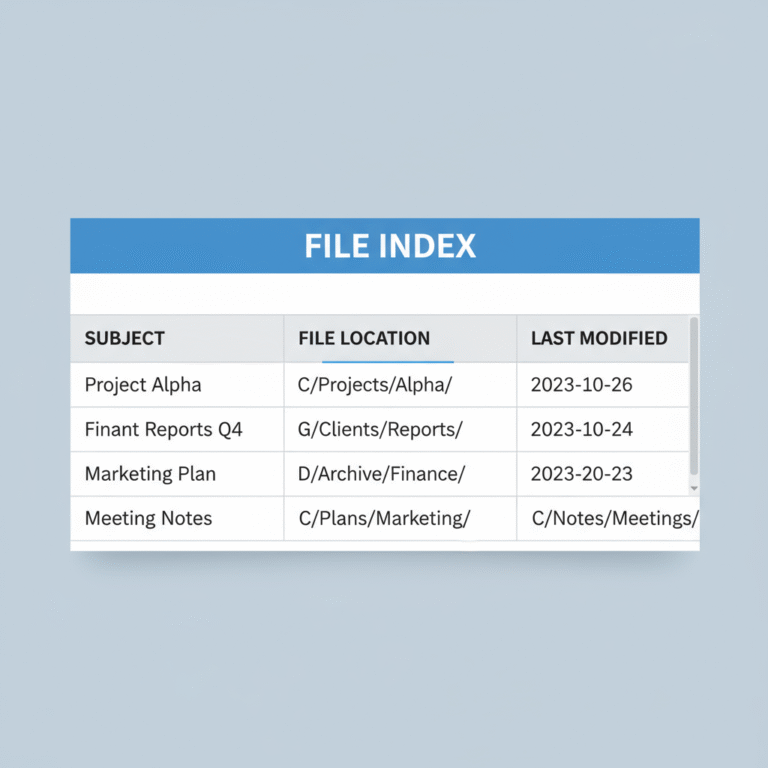
Files get piled up in your laptop, just like stuff in an old drawer. We’ve all been there—assignments tossed everywhere, random screenshots, and a dozen “final” versions of the same essay. It’s a mess, and when you need something fast? Yeah, good luck with that.
Seriously though, getting your digital files in order can actually make your life way easier. No more frantic searching when your teacher wants that one assignment, or when you’re trying to cram for an exam. Just a couple clicks and—boom—it’s right there.
I’m not saying you have to be some organization guru, but a little effort goes a long way. You’ll be way less stressed, cross things off your list in record time, and honestly, your friends might start calling you the digital guru. Pretty cool, right?
Simple Ways to Organize Your Digital Notes
1.Create Main Folders for Each Subject
First, make separate folders for every subject you study. You could totally go with folders like Marketing, Finance, HR, Operations, MIS, or Research—whatever works for you. Trust me, it keeps your notes and assignments from turning into a hot mess. Makes finding stuff way easier, and hey, who doesn’t love a bit of order in their digital life? You won’t have to dig through piles of stuff just to find that one worksheet—everything’s right where you left it. Honestly, it saves you from those “Wait, where’d I put that?” moments. Super handy, trust me.
2.Make sub-folders inside your subject folders
Hey, here’s a pro tip: don’t just toss everything into one giant folder and hope for the best. Inside each subject, set up little sub-folders—like Notes, Assignments, Case Studies, Presentations, Reference Materials, all that good stuff. Makes life a whole lot easier when you’re hunting for something, trust me.
3.Name Your Files Clearly
Name your files in a way that tells you what’s inside. Instead of “final” or “doc1,” go for something like Subject_Bio_Assignment1 or Math_Notes_Week3. Saves you from playing the guessing game later, and you’ll find your stuff way faster.

4.Add Dates to File Names
Hey, here’s a little life hack: toss the date onto your file names! So instead of a boring “Assignment” or “Notes,” go for “Assignment_2024-06-06” or something like that. Makes it way easier to spot the latest version—no more digging through a mess of “final_final_THISone.docx” files. Your future self will thank you, promise.
5.Use Cloud Storage for Backup
Hey, seriously, don’t mess around with your files—put ‘em somewhere safe! Cloud storage like Google Drive or Dropbox is pretty much a lifesaver. If your laptop ever dies (or you just straight-up lose it… it happens), you’ll still have your stuff. Plus, it’s super handy to grab your notes from your phone or anywhere whenever you need them.
6.Organize Your Downloads Folder
Downloaded files can pile up and make the folder look messy. Make it a habit to move important files from the downloads folder to the correct subject folders. Delete unnecessary downloads to keep the space clean.
7.Delete Unnecessary and Duplicate Files
Having too many old or same files makes it confusing to find the right one. Every week, spend a few minutes deleting old or duplicate files. Cleaning up files like this will keep your folders in order and your device won’t slow down.
8.Use a Simple Index File
You can maintain an Excel sheet or Word file as a “File Index” where you list important documents and their folder location. This acts as a tracker and helps you locate files quickly.

9. Set a Weekly File-Organizing Routine
Hey, here’s a friendly tip: just save yourself the headache and block out 10 minutes each week—maybe right before your favorite show or while your coffee brews. Take a quick pass through your files, clear out the random junk, and actually give your stuff real names (no more “untitled” disasters). Future you is going to be so relieved when everything’s easy to find, instead of panicking before a big deadline.
Keep Your Study Files Neat and Easy to Find
Keeping your digital files in order isn’t hard, and it saves you from a ton of headaches later. Just make some folders for your classes, give your files names that actually make sense (no more “finalfinalversion3.pdf”—we’ve all been there), and please, back things up somewhere safe. For real, it’s just so much nicer when you know exactly where everything is. No last-minute freakouts or wild goose chases for your notes when the pressure’s on. Hey, just a bit of digital sprucing up now and you’ll be cruising through your days later on—way less stress, way more chill. Later on, you’ll thank yourself for organizing now. You’ve so got it!
Referencex
How I Organize Digital Files For My Classes | Veroniiiica
https://share.google/27ehTnQfdkkszBZfa
11 Steps To Organizing Digital Files for Academic Success
https://share.google/miFpE4V5VEassimeS
Digital Files | Student Success & Retention Innovation
https://share.google/UqhZQc0Saf5nuUrjj
11 ideas for how to organize digital files
https://share.google/N0JPqfCLSWMza2n72
Image source:
FAQs
1. What is a digital file?
A digital file is an electronic package of information that can be stored, shared, and processed on computers, smartphones, and other digital devices. Unlike paper documents, a digital file exists in binary form, making it easy to duplicate without losing quality. Common examples include documents, images, videos, and audio recordings. The main advantage of a digital file is its portability, as it can be transferred instantly without the limitations of physical storage.
2. What are the most common types of digital files?
There are many kinds of digital files depending on the purpose. Document files include PDF, DOCX, and TXT. Images are saved as JPEG, PNG, or GIF. Audio formats include MP3, WAV, and AAC, while video files are often MP4, AVI, or MOV. Compressed digital files, such as ZIP and RAR, are used to package multiple items into a smaller size for easier sharing and storage.
3. Why are digital files important in today’s world?
Digital files are essential in modern life because they make communication, education, and business more efficient. They reduce the need for paper, allow instant sharing across the globe, and store information in a compact way. Businesses rely on digital files for contracts and reports, while students use them for projects and eBooks. Even governments now issue certificates and licenses as digital files, making daily life smoother and more connected.
4. How do I keep my digital files organized?
The best way to organize digital files is by creating a clear folder structure. You can separate personal, work, and academic files into different categories. Descriptive filenames, such as including dates or project names, help with quick identification. Cloud storage solutions like Google Drive, Dropbox, or OneDrive make it possible to access digital files from multiple devices. File management tools and search functions also speed up locating the right file when needed.
5. What is the difference between a digital file and a physical file?
A digital file is intangible and stored electronically, while a physical file is a paper-based document. Digital files can be copied infinitely without quality loss, but photocopying a physical file often degrades quality. Physical files require space and can be damaged, whereas digital files are more durable if backed up. However, digital files require cybersecurity measures to prevent unauthorized access.
6. How can I convert physical documents into digital files?
Converting physical documents into digital files can be done using scanners, mobile apps, or specialized digitization tools. Many smartphone apps allow you to take a picture of a document and turn it into a PDF or image. Optical Character Recognition (OCR) software can even extract text from scanned images, turning them into editable digital files. Once converted, these files can be stored on your device or in the cloud.
7. What are the risks of storing digital files?
Although convenient, storing digital files has some risks. Files can be lost due to hardware crashes, corrupted storage, accidental deletion, or hacking. Malware and ransomware also pose threats to sensitive digital files. To reduce risks, it is important to keep backups, use reliable antivirus software, and protect accounts with strong passwords and two-factor authentication.
8. How do I share a these file securely?
Secure sharing of a digital file can be done through encrypted email services or cloud platforms like Google Drive, Dropbox, and OneDrive. Some services let you create password-protected links for sensitive documents. Another option is compressing and encrypting a digital file with software like 7-Zip before sending it. Avoid sharing important files over unsecured public Wi-Fi to maintain security.
9. Can digital files be permanently deleted?
Deleting a digital file doesn’t always remove it completely. In most systems, files first go to the recycle bin or trash folder. Even after that, traces can remain on the storage device until overwritten. For complete removal, you need secure deletion tools that overwrite the data. For highly sensitive information, physical destruction of the storage device may be the only guaranteed method.
10. What is a digital file format?
A digital file format determines how information inside a file is encoded and used. Each format is designed for a particular type of content and software. For example, DOCX files are for text editing, while JPEGs are optimized for images. Choosing the right digital file format ensures compatibility with applications and devices, making the file easier to use and share.
11. How do cloud services help with file storage?
Cloud services are widely used for digital file storage because they allow access from anywhere with an internet connection. They also provide automatic backup, version history, and real-time collaboration. Services like Google Drive, Dropbox, and iCloud make it easier to manage digital files without worrying about local hardware failure. Cloud storage also helps save physical storage space and offers secure sharing options.
12. What is file compression?
File compression reduces the size of a file to save space or speed up transfers. There are two main types: lossless and lossy compression. Lossless compression keeps all data intact, making it useful for text and archives such as ZIP files. Lossy compression removes some data to reduce size, commonly used in JPEG images and MP4 videos. Compression is especially helpful when emailing or uploading large digital files.
13. How can I recover a lost file?
If you lose a digital file, first check the recycle bin or trash folder. If it was deleted permanently, file recovery software like Recuva or EaseUS can sometimes restore it. For cloud-stored files, many services offer version history or recovery options. The faster you attempt recovery, the higher the chances of restoring the digital file before it gets overwritten by new data.
14. What are file permissions?
Digital file permissions control who can view, edit, or share a file. On computers, you can set access rights for different users, while cloud platforms allow you to assign roles like viewer or editor. Setting proper permissions ensures that sensitive digital files are protected from unauthorized use while still accessible to those who need them.
15. What is the future of these files?
The future of the digital file is evolving toward smarter storage, improved security, and integration with emerging technologies. Artificial intelligence may help categorize and retrieve files more efficiently. Blockchain could be used to verify authenticity and protect against tampering. With advances in cloud and edge computing, digital files will become even more portable and secure, shaping the way we work and share information in the future
Penned by Aliya Altaf Mulla
Edited by Ragi Gilani, Research Analyst
For any feedback mail us at [email protected]
Transform Your Brand's Engagement with India's Youth
Drive massive brand engagement with 10 million+ college students across 3,000+ premier institutions, both online and offline. EvePaper is India’s leading youth marketing consultancy, connecting brands with the next generation of consumers through innovative, engagement-driven campaigns. Know More.
Mail us at [email protected]